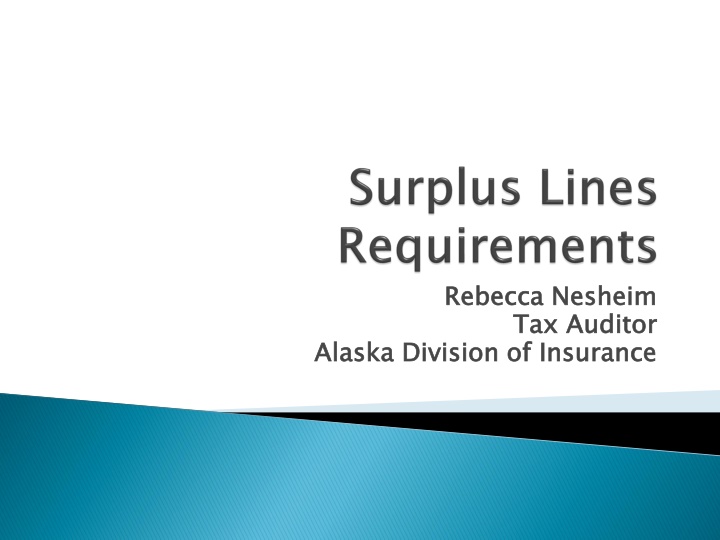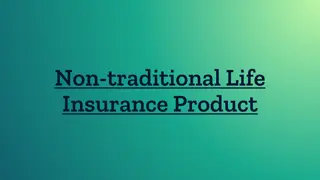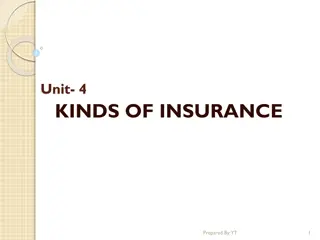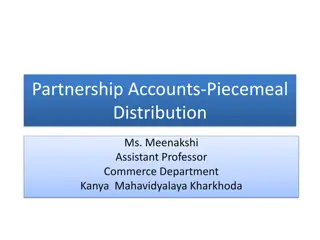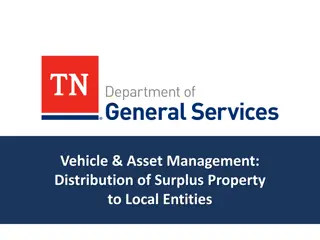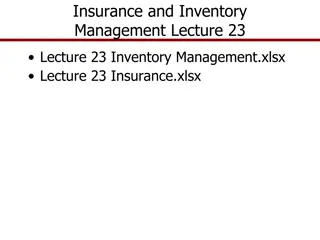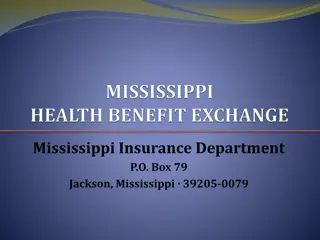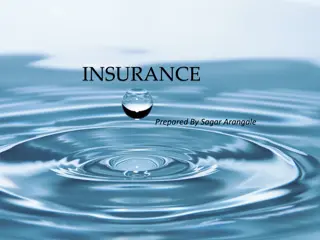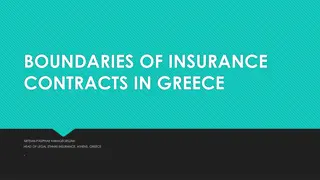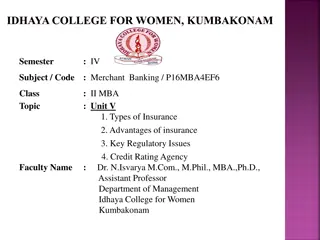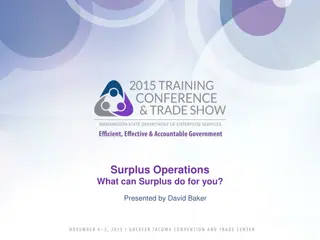Surplus Lines Insurance Regulations
Explore the key aspects of the Alaska Division of Insurance's surplus lines regulations, including definitions of "home state" and coverage placement criteria. Learn about the restrictions on placing certain types of insurance in surplus lines and the requirements for eligible surplus lines insurers.
Download Presentation

Please find below an Image/Link to download the presentation.
The content on the website is provided AS IS for your information and personal use only. It may not be sold, licensed, or shared on other websites without obtaining consent from the author.If you encounter any issues during the download, it is possible that the publisher has removed the file from their server.
You are allowed to download the files provided on this website for personal or commercial use, subject to the condition that they are used lawfully. All files are the property of their respective owners.
The content on the website is provided AS IS for your information and personal use only. It may not be sold, licensed, or shared on other websites without obtaining consent from the author.
E N D
Presentation Transcript
Rebecca Nesheim Tax Auditor Rebecca Nesheim Tax Auditor Alaska Division of Insurance Alaska Division of Insurance
July 21, 2011, the NRRA went into effect. The significant changes were made to create more consistency to how surplus lines is applied across the country. One of the biggest changes was to the home state of the insured. Once the home state of the insured is determined, that state s laws are followed.
AS 21.34.900(8) "home state" means: (1) the state in which an insured maintains its principal place of business or, in the case of an individual, the individual's principal residence; or (2) if 100 percent of the insured risk is located out of the state referred to in (1) of this subparagraph, the state to which the greatest percentage of the insured's taxable premium for that insurance contract is allocated. AS 21.34.900(8) "home state" means: Alaska s definition for principal place of business of an insured: the state where the insured maintains its headquarters and where the insured's high-level officers direct control and coordinate the business activities of the insured.
The following cannot be placed in surplus lines AS 21.34.020(a) The following cannot be placed in surplus lines AS 21.34.020(a) Reinsurance Wet marine and transportation insurance Independently procured insurance Life insurance Health insurance except as provided in the surplus lines chapter (health care) Annuity contracts
AS 21.34.020 Coverage may be placed in surplus lines IF AS 21.34.020 Coverage may be placed in surplus lines IF The insurer is an eligible surplus lines insurer. The full amount, kind, or class of insurance cannot be obtained from insurers who are admitted to do business in this state. The producing broker has conducted and documented a diligent search. The director has authorized an exception from 2. All other requirements of chapter 34 of the statute are met. Exempt Commercial Purchaser if the policyholder meets the standards of an exempt commercial purchaser then insurance may be procured from a surplus lines broker without complying with 2, 3, and 4 as long as certain requirements are met. 1. 2. 3. 4. 5. 6.
Located on web at https://www.commerce.alaska.gov/web/ins/Su rplusLines.aspx Alaska White List Eligible Surplus Lines Insurers consider using Company Search for real time determination of an insurer s status. NAIC s Quarterly Listing of Alien Insurers
The diligent search must be with insurers who are admitted to transact business in Alaska and are ACTUALLY writing the particular kind or class of insurance required by the client. The Alaska Division has an Affidavit of Due Diligence on the website that can be used but is not required. The diligent search must be completed prior to binding. The documentation must be provided to surplus lines broker within 15 days from binding.
(1) documentation of at least two declinations from admitted insurers who are actually writing the coverage required by the insured; (2) evidence that the full amount, kind, or class of insurance could not be obtained from all admitted insurers the producer can reach; (3) affirmation that the coverage is on the director's current surplus lines placement list under 3 AAC 25.040; (4) an exception from the director under AS 21.34.020(a)(4). (5) Exempt Commercial Purchaser
A declination from a company not writing the coverage the insured needs is not an adequate declination. Bulletin B 15-10 is guidelines for diligent search. Here are some examples of unacceptable diligent search documentation.
Must have a qualified risk manager which is defined in the NRRA. Paid aggregate nationwide commercial property and casualty insurance premiums in excess of $100,000 in the immediately preceding 12 months, and Meets certain criteria identified in Bulletin 19- 15.
(1) the broker has disclosed to the exempt commercial purchaser that the insurance may or may not be available from the admitted market that may provide greater protection with more regulatory oversight; and (2) the exempt commercial purchaser has subsequently requested in writing procure or place the insurance from a nonadmitted insurer. requested in writing that the broker
Notification AS 21.34.110 (prior to binding) Notification AS 21.34.110 (prior to binding) The insurer does not hold a certificate of authority issued in Alaska, 1. The insurer is not subject to the supervision by the Division, and 2. In the event of insolvency, losses will not be covered by the Alaska Insurance Guaranty Association. 3. Written documentation and proof of delivery must be in the insured s file. 4.
Prompt delivery if the policy is not available within 30 days from binding, then other evidence of insurance such as a binder, cover note, confirmation of coverage, or whatever name you call it, is required to be delivered to the insured within 30 days of binding. Evidence of insurance is a policy/declaration, binder, cover note, confirmation of coverage, endorsement (both premium and nonpremium bearing), company audit, and certificates.
Description and location of the subject of insurance. General description of the coverages of the insurance. Premium and rate charged and taxes to be collected. Name and address of the insured. Name of each insurance company and the percentage of the entire risk assumed by each (if just one company then 100% is assumed). Name and license number of the surplus lines broker.
Division of Insurance Recommended Language when referencing the quote in evidence of insurance. Division of Insurance Recommended Language when referencing the quote in evidence of insurance. Quote Number ______, dated ________ is incorporated by reference and is part of this binder as though fully set forth herein.
Disclosure Language AS 21.34.100(e) After binding on all evidence of insurance Disclosure Language AS 21.34.100(e) After binding must be verbatim on all evidence of insurance must be verbatim This is evidence of insurance procured and developed under the Alaska Surplus Lines Law, AS 21.34. It is not covered by the Alaska Insurance Guaranty Association Act, AS 21.80. Preferably, this should be on the first page. However, a separate document at the beginning of the evidence of insurance is acceptable. Do not place over any words so they become illegible.
The Quarterly Report is to be filed in OPTins along with the payments for premium tax and filing fees by the business entity. Bulletin B 17-08. Quarterly Affidavit Attestation to the accuracy of the Quarterly Report. Quarterly Report summary and list of transactions.
Producing broker business entiy name and license number not matching. Producing broker information is for an individual. Mismatch between NAIC Co-codes and Insurer names. Endorsement policy term start date not matching initial policy. Endorsement not identified correctly as endorsement and invoice date missing Missing Lloyd syndicates. Subscription policy insurers % of coverage not adding up to 100% of risk.
At a minimum, the state in which the risk is located must be in the location of risk. If multi-state policy, then there are several ways to provide the information in location of risk: Either identify each state in the location of risk column or Attach a separate document listing the states or locations. If all states are involved in the risk, you may state all 50 states instead of listing each one separately.
Due Dates for Quarterly Reports and Payments AS 21.34.170 and .180 Due Dates for Quarterly Reports and Payments AS 21.34.170 and .180 Due Dates Due Dates Related Months Related Months 1stQuarter: June 1 - - - - - - - - -January, February, March 2ndQuarter: September 1 - - - - -April, May, June 3rdQuarter: December 1 - - - - - July, August, September 4thQuarter: March 1 - - - - - - - October, November, December
Due dates: Same as the Quarterly Report. Premium base: gross premium less returned premium. This includes taxable company fees. Tax Filing Fee Tax: 2.7% Filing Fee: 1% B 04-14: what fees are included in premium.
Exempt from Tax and Filing Fees AS 21.34.180(i) Exempt from Tax and Filing Fees AS 21.34.180(i) Insurance of risks of state government or its political subdivision, to an agency of state government or its political subdivisions, or to insurance of aircraft primarily engaged in interstate or foreign commerce.
Late file penalties Late file penalties AS 21.34.170(c) and 3 AAC 25.100(e) AS 21.34.170(c) and 3 AAC 25.100(e) 1 30 days late: $100 31 60 days late: $200 More than 60 days late: $300
Late Payment Penalties AS 21.34.180(j) and AS 21.34.190(b) Late Payment Penalties AS 21.34.180(j) and AS 21.34.190(b) Tax Penalty: Penalty of 5% of the tax due plus $50 per month or part of a month up to 5 months or 25% of the tax due plus $250. 1. Interest 1% of the tax due per month or part of a month until paid. 2. Filing Fees Penalty: Penalty of 2% of the filing fee due per month or part of a month until paid plus $250. 3.
Bulletin 08-06 is the current language for the notice that is to be provided with the policy. Although it is the insurers responsibility to provide, it is the surplus lines broker s responsibility to ensure it is with the policy.
Wet Marine and Transportation insurance AS 21.34.900(15) means one or more of the following: Wet Marine and Transportation insurance AS 21.34.900(15) (A) insurance upon, of interest in, or relating to vessels, crafts, hulls, except vessels of 50 displacement tons or less; (Alaska regulation states gross registered tons is evidence of displacement tons) (B) insurance of marine builders risks, marine war risks, and contracts of marine protection and indemnity insurance; (C) insurance of freight and disbursements pertaining to a subject of insurance coming within this paragraph; or (D) insurance of personal property and interests in personal property, in course of exportation from or importation into a country or in the course of coastal or inland water transportation, including transportation by land, water, or air from point of origin to final destination in connection with any and all risks or perils of navigation, transit, or transportation, and while being repaired for and while awaiting shipment, and during any delays, transshipment, or reshipment incident to them.
Preferred to have filed in OPTins but not required. Due March 1. Tax rate: .75%
Workers Compensation in surplus lines: AS 21.34.030. Any policy unable to be placed in the admitted market needs to go through the residual marketplace through NCCI first before looking into surplus lines. Health Care in surplus lines: AS 21.34.035 Please contact me if you have either of these situations to discuss the additional requirements before placement can occur.
All agencies should have procedures covering the processing of a surplus lines transaction from the point the insured contacts a producing broker and/or surplus lines broker up to the expiration of the policy including endorsements and company audits. Financial filing requirements, including but not limited to: OPTins Due Dates Penalties If you would like me to review them, please contact me.
Rebecca Nesheim rebecca.nesheim@alaska.gov (907) 465-2584 Courtney Reeves courtney.reeves@alaska.gov (907) 465-4615
